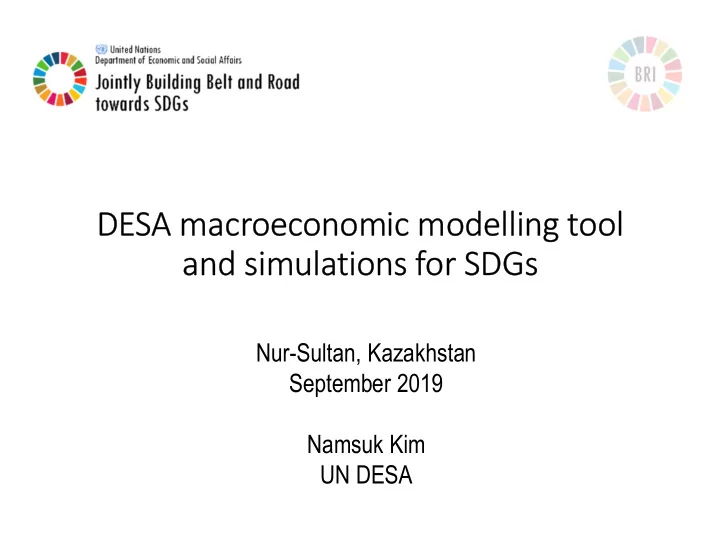

DESA macroeconomic modelling tool and simulations for SDGs Nur-Sultan, Kazakhstan September 2019 Namsuk Kim UN DESA
Outline 1. Modeling tool and methodology 2. Simulations 3. Modelling capacity building
Modelling tool and methodology • Expanded World Economic Forecasting Model (WEFM-e) • Asses impact of BRI on economic development of selected countries • Simulate impact of investments in Infrastructure on income growth, labor market, fiscal sustainability, poverty reduction and so on
World Economic Forecasting Model • Started linking country models in 1970s (LINK). • Since 2005, integrated modelling tool covering 176 countries. • Multi-country forecasting model • Error-correction principle • Supply, Demand, Monetary sides
UN World Economic Forecasting Model Exogenous total factor productivity Personal consumption Population Potential Output Labor output Investment supply Shares Labor on participation Government Export Output output consumption growth gap Exports and Output imports per capita Inflation Interest rates Exchange rate against US inflation USD
WEFM - production side • Potential output growth depends on Trend growth of the Total Factor Productivity (TFP), change in the labor supply (labor force projection) and growth of exports �𝑍𝐺𝑈 � = 𝛽[�𝑀𝐺𝑂 � + �𝑈𝐺𝑄 � ] + 1 − 𝛽 �𝑌𝑈𝑆 � • Trend growth of TFP depends on TFP growth itself with an error term guarantying that labor productivity does not systematically deviates from the trend growth of TFP 𝑍𝐹𝑆 ��� �𝑈𝐺𝑄 � = 𝜔�𝑈𝐺𝑄 ��� + 1 − 𝜔 �𝑈𝐺𝑄 � + (1 − 𝜔) 1 𝑀𝑂𝑂 ��� − �𝑈𝐺𝑄 ��� 𝑍𝐹𝑆 ��� 3 𝑀𝑂𝑂 ��� • TFP growth is kept constant at 2%, 3% or 4% depending on the level of country development
Changes in WEFM-e • Create simplified (reduced-form) version of complex non-linear relationships for • infrastructure investment and education level in production • labor participation based on GDP per capita and education level • Poverty reduction • Consumption and investment behavior in relation to expected growth and the real interest rate • Government debt accumulation and its impact on the country risk premium, real interest rate and the exchange rate with the back loop in private consumption and investment
Outline 1. Modeling tool and methodology 2. Simulations 3. Modelling capacity building
Simulations for Kazakhstan • BRI related investments amounted $4.4 billion during 2012 – 2020. • Medium period projection until 2023
0% 3% 6% 9% 2012 2013 2014 Investment growth Original 2015 2016 2017 Modified 2018 2019 2020 2021 2022 2023
Investment growth (Modified Model) 15% 10% 5% 0% -5% 2012 2013 2014 2015 2016 2017 2018 2019 2020 2021 2022 2023 Infrastructure Inv Private Gvt
Trend productivity growth 5% 3% 1% 2012 2014 2016 2018 2020 2022 Original Modified
1% 4% 7% 2012 2013 Potential output growth 2014 Original 2015 2016 2017 Modified 2018 2019 2020 2021 2022 2023
0% 3% 6% 9% 2012 2013 2014 Original GDP growth 2015 2016 2017 Modified 2018 2019 2020 2021 2022 2023
Labor force participation 70 60 50 40 2012 2013 2014 2015 2016 2017 2018 2019 2020 2021 2022 2023 Modified_Female Modified_Male Modified Original
-8 -4 0 4 2012 2013 2014 Original Fiscal balance 2015 2016 2017 Modified 2018 2019 2020 2021 2022 2023
10 20 30 0 2012 2013 2014 Deb-to-GDP ratio 2015 Original 2016 2017 Modified 2018 2019 2020 2021 2022 2023
220000 240000 260000 280000 300000 2012 2013 CO2 emission (kt) 2014 2015 2016 2017 2018 2019 2020 2021 2022 2023
BRI related investment (SDG 9, 11) … • Limited impact in labor force participation and jobs (SDG 8) • Limited impact on decreasing the gender gap (SDG 5, 8) • Boosts the productivity growth (SDG 4, 8, 17) • Leads to a faster output growth (SDG 8) • Gov deficit and debt manageable (SDG 17) • Overall, the positibe impacts on economic growth, cautions on environment and social indicators.
Future work on WEFM-e • Data • Calibrations • Region-integrated simulations + Qualitative studies
Outline 1. Modeling tool and methodology 2. Simulations 3. Modelling capacity building
Planned project activities • Online access to simulation scenarios at www.brisdgs.org • Interim report (mid 2019), and final report (mid 2020) • Regional workshops – Bangkok (Sep 2019), Tbilisi (Oct 2019), China (early 2020) • National workshops in other countries - Kyrgyzstan, Azerbaijan, … (2019-20). • In-depth training course on modelling tools including WEFM- e if requested
Contact: kimnamsuk@un.org
Recommend
More recommend